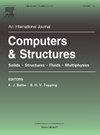Transfer learning-based artificial neural networks for hysteresis response prediction of steel braces
IF 4.4
2区 工程技术
Q1 COMPUTER SCIENCE, INTERDISCIPLINARY APPLICATIONS
引用次数: 0
Abstract
This paper proposes a novel data-driven surrogate model for predicting the hysteresis response, i.e., axial force – axial deformation, of steel braces in concentrically braced frames under seismic loading using transfer learning-based artificial neural networks. Transfer learning is utilized to leverage pre-trained baseline long short-term memory networks and transfer its knowledge to the new hysteresis surrogate model. The proposed model is validated using four case studies involving various combinations of input data obtained from laboratory tests and data generated using random earthquake-induced vibration, featuring a wide range of frequency contents, amplitudes, and durations. A pseudo-dynamic analysis is then performed on a steel braced frame system to demonstrate the application of the proposed surrogate model in system-level response evaluation while verifying the performance of the model in real-time seismic simulations. The results obtained from the validation study confirm that the proposed brace hysteresis model can properly estimate the underlying physical relationship between the input displacement and output force using the transfer learning approach. The proposed model offers an efficient method to evaluate the dynamic response of steel braced frames.
基于迁移学习的人工神经网络钢支撑滞回响应预测
本文提出了一种新的数据驱动代理模型,用于预测地震荷载下同心支撑框架钢支撑的滞后响应,即轴向力-轴向变形,使用基于迁移学习的人工神经网络。迁移学习是利用预先训练的基线长短期记忆网络,并将其知识转移到新的滞后替代模型。所提出的模型通过四个案例研究进行了验证,这些案例研究涉及从实验室测试获得的输入数据和使用随机地震诱发振动产生的数据的各种组合,这些数据具有广泛的频率内容、幅度和持续时间。然后对钢支撑框架系统进行了伪动力分析,以证明所提出的替代模型在系统级响应评估中的应用,同时验证了该模型在实时地震模拟中的性能。验证研究的结果证实,所提出的支撑滞后模型可以使用迁移学习方法正确估计输入位移和输出力之间的潜在物理关系。该模型为评价钢支撑框架的动力响应提供了一种有效的方法。
本文章由计算机程序翻译,如有差异,请以英文原文为准。
求助全文
约1分钟内获得全文
求助全文
来源期刊

Computers & Structures
工程技术-工程:土木
CiteScore
8.80
自引率
6.40%
发文量
122
审稿时长
33 days
期刊介绍:
Computers & Structures publishes advances in the development and use of computational methods for the solution of problems in engineering and the sciences. The range of appropriate contributions is wide, and includes papers on establishing appropriate mathematical models and their numerical solution in all areas of mechanics. The journal also includes articles that present a substantial review of a field in the topics of the journal.
 求助内容:
求助内容: 应助结果提醒方式:
应助结果提醒方式:


